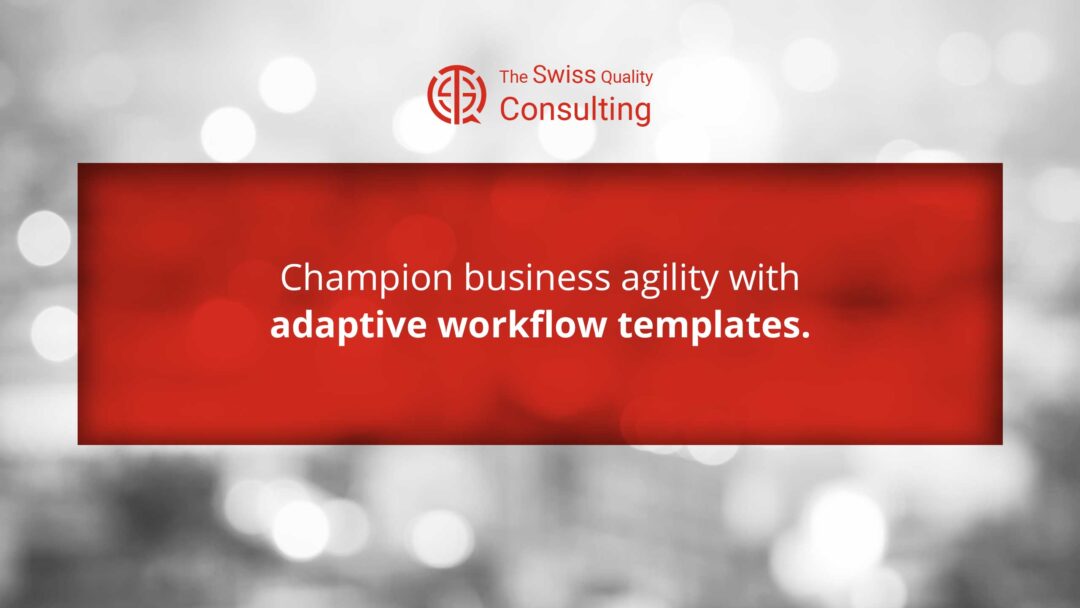Enhancing Operational Flexibility for Competitive Advantage
Introduction
In the dynamic business landscape of today, championing business agility with adaptive workflow templates has become a pivotal strategy for organizations aiming to maintain competitiveness and efficiency. This article is tailored for business executives, mid-level managers, and entrepreneurs seeking insights into leveraging adaptive workflow templates to foster agility in their operations.
The Role of Adaptive Workflow Templates in Business Agility
In today’s dynamic and rapidly evolving business landscape, adaptive workflow templates have emerged as a cornerstone of organizational agility and resilience. Unlike rigid, predefined workflows that can become obsolete in the face of change, adaptive workflow templates provide a flexible and customizable framework for managing processes, enabling businesses to respond swiftly and effectively to shifting market demands, internal dynamics, and emerging opportunities.
At the heart of this adaptability lies the recognition that business processes are not static entities; they must evolve continuously to align with the changing needs of the organization and the external environment. Adaptive workflow templates embrace this fluidity, providing a foundation for dynamic process management that can be tailored to specific circumstances and adapted as new requirements arise.
The benefits of adopting adaptive workflow templates extend far beyond mere flexibility; they encompass a wide spectrum of organizational advantages, including:
Enhanced Process Efficiency: Adaptive workflow templates streamline processes by eliminating unnecessary steps, automating repetitive tasks, and optimizing resource utilization. This efficiency leads to reduced costs, improved productivity, and faster cycle times.
Improved Collaboration and Communication: Adaptive workflow templates facilitate seamless collaboration and communication among team members by clearly defining roles, responsibilities, and task handovers. This clarity enhances coordination, reduces errors, and expedites process execution.
Reduced Risk and Errors: Adaptive workflow templates incorporate control points, checkpoints, and risk mitigation strategies to minimize the likelihood of errors and ensure adherence to regulatory requirements. This reduces the risk of compliance issues, financial penalties, and reputational damage.
Continuous Improvement and Innovation: Adaptive workflow templates foster a culture of continuous improvement by providing a platform for experimentation, feedback loops, and data-driven decision-making. This ongoing refinement leads to process optimization, innovation, and sustainable growth.
Empowerment and Agility: Adaptive workflow templates empower employees to take ownership of their tasks, make informed decisions, and adapt their work to changing circumstances. This empowerment fosters a culture of agility, enabling businesses to respond quickly to market shifts and internal dynamics.
In essence, adaptive workflow templates are not merely a collection of pre-defined steps; they are a catalyst for organizational transformation, empowering businesses to navigate the complexities of today’s dynamic business environment with agility, resilience, and a focus on continuous improvement. By embracing adaptive workflow templates, businesses can streamline operations, enhance collaboration, reduce risk, foster innovation, and achieve sustainable success in an ever-changing world.
Empowering Quick Adaptation to Market Changes
By adopting adaptive workflow templates, businesses can rapidly modify their processes, ensuring agility and responsiveness to market trends and customer demands.
Change Management and Workflow Adaptation
Successfully integrating adaptive workflow templates into business operations requires effective change management. It involves redefining processes and encouraging a culture that embraces flexibility and continuous improvement.
Strategies for Smooth Integration and Adoption
Implementing change management strategies is essential for the smooth adoption of adaptive workflow templates, ensuring that all team members are aligned and trained to utilize these new systems effectively.
Leadership in Promoting Agile Practices
Leadership is critical in driving the adoption of adaptive workflow templates. Executive coaching services are now increasingly focusing on equipping leaders with the skills to promote agility and oversee the integration of adaptive workflows in their organizations.
Guiding Teams Towards Agile Operations
Through executive coaching, leaders are prepared to guide their teams effectively in adopting agile practices, fostering an environment of innovation and flexibility.
Effective Communication in Implementing Adaptive Workflows
Effective communication is key to implementing adaptive workflow templates. It ensures that the purpose, benefits, and methods of these agile practices are clearly understood and embraced across the organization.
Building an Agile Mindset Among Teams
Communication strategies are essential to building an agile mindset among teams, enabling them to understand the importance of adaptive workflows and their role in enhancing business agility.
Generative AI in Refining Adaptive Workflow Templates
Generative Artificial Intelligence (AI) can significantly enhance the functionality of adaptive workflow templates. AI technologies can analyze data patterns, predict operational needs, and suggest improvements to workflow designs.
Leveraging AI for Optimized Workflow Design
Generative AI provides businesses with the tools to optimize their workflow templates, ensuring that they are continuously evolving and adapting to the latest business requirements and market conditions.
Conclusion Championing Business Agility with Adaptive Workflow Templates
In conclusion, championing business agility with adaptive workflow templates is crucial for organizations striving to remain agile and competitive in today’s fast-paced market. By leveraging these templates and incorporating generative AI, businesses can achieve greater operational flexibility, faster response to market changes, and sustained growth.
#BusinessAgility, #WorkflowTemplates, #OperationalEfficiency, #AIinBusiness, #ChangeManagement

